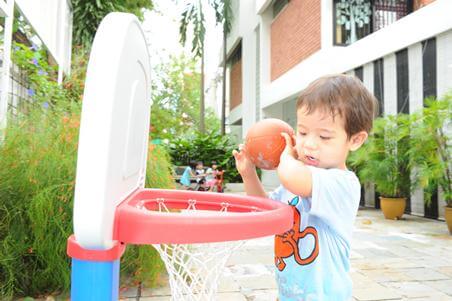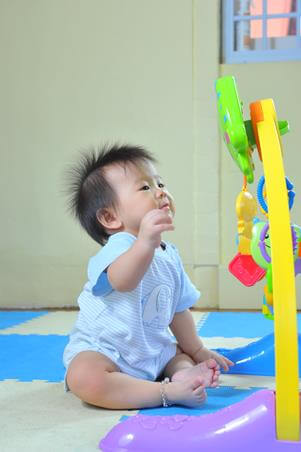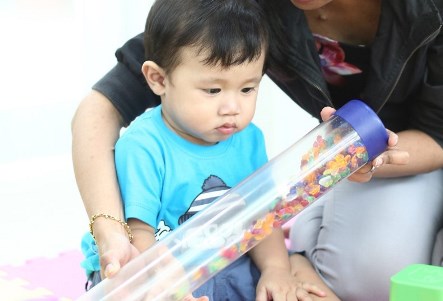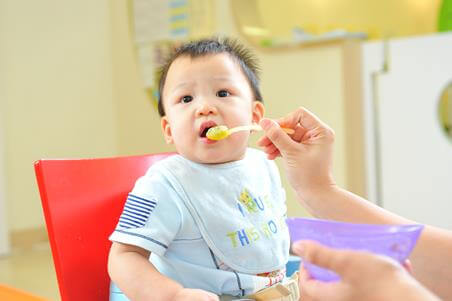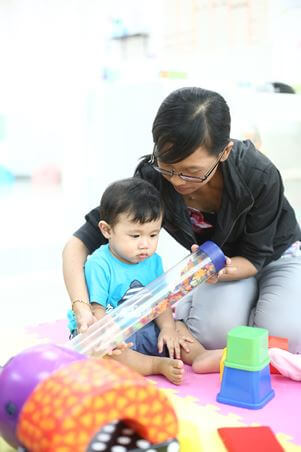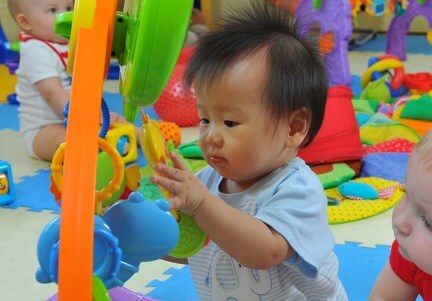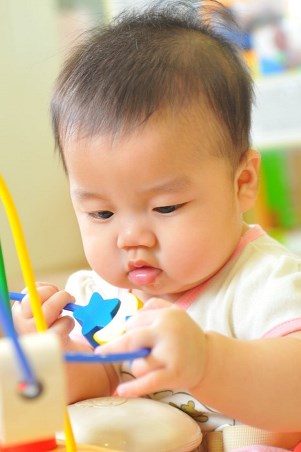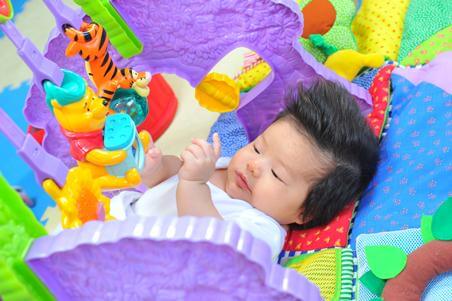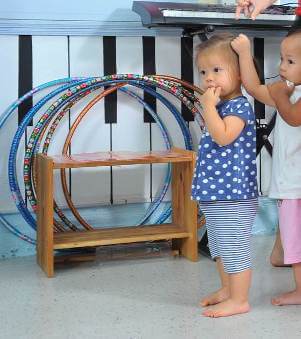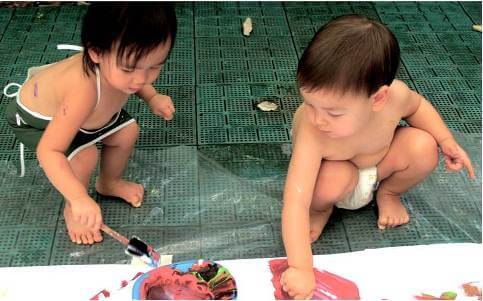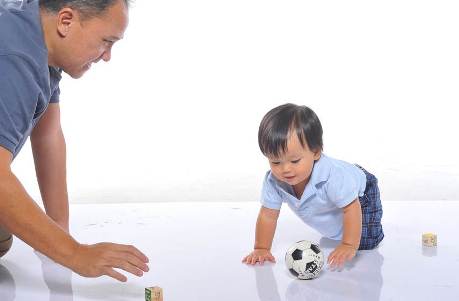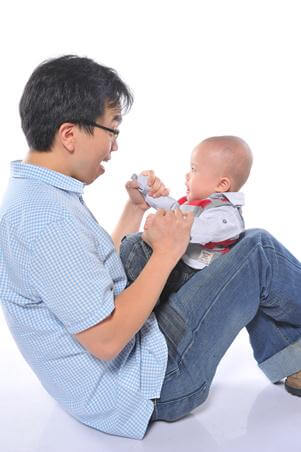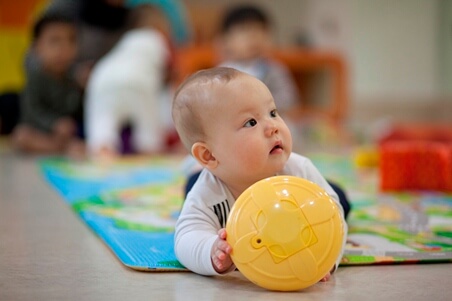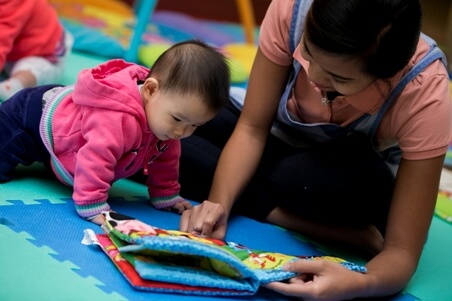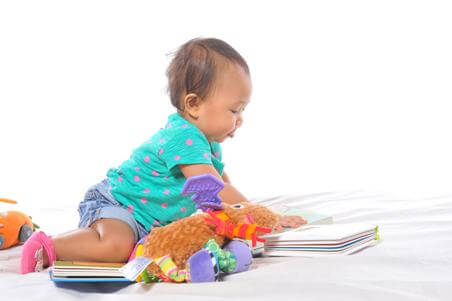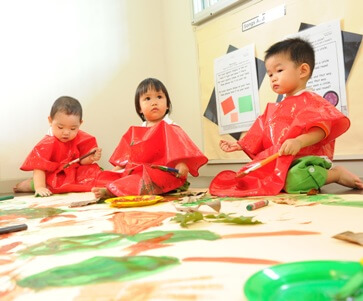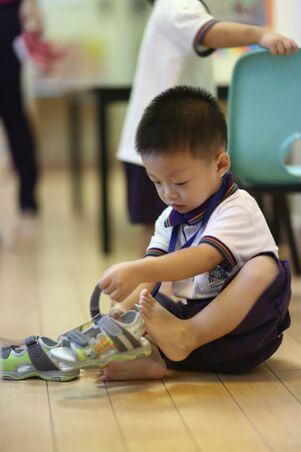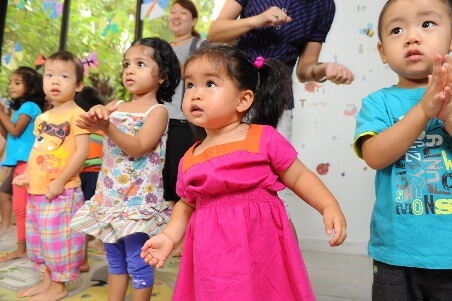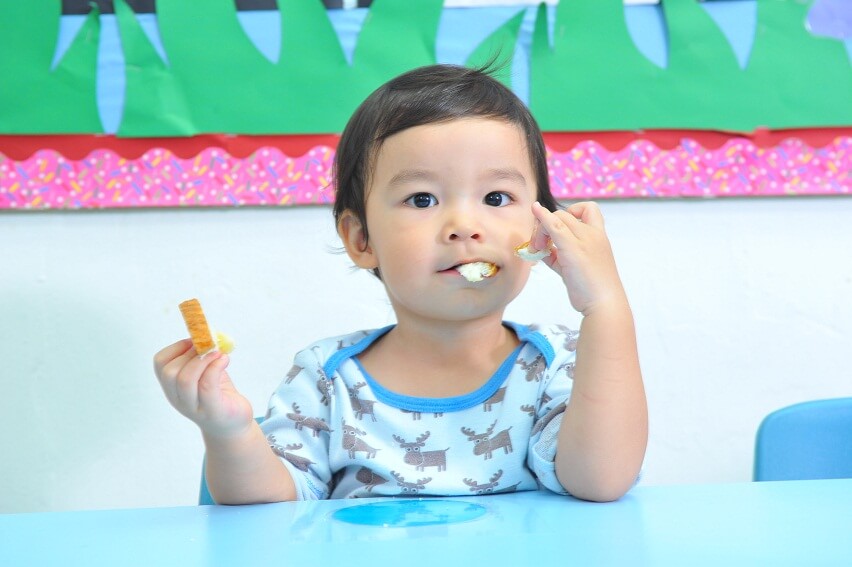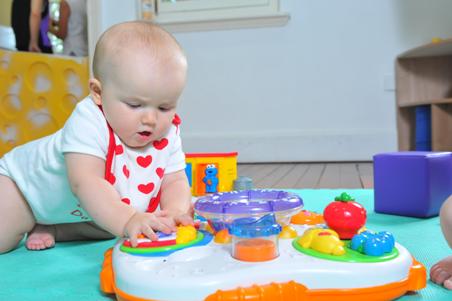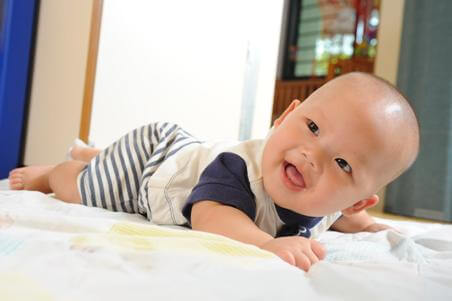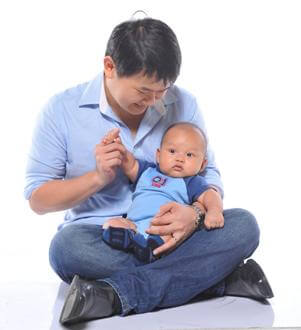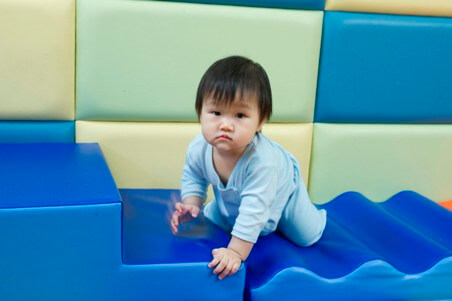WHAT YOU CAN DO |
| Go fishing for toys!
Tie a soft toy to one end of a long piece of yarn and put the other end in your baby's hand. Show her how she can tug the string to draw the toy closer to her. Toss the toy out and help
your baby to pull it back. Through this activity, your baby is practising her grasping skills and her eye-hand coordination! |
| | |
 | Opportunities for movement strengthen motor development.
Through physical movement, your baby can discover his abilities and what he can do. Pile up pillows and cushions on the floor and let your toddler climb
and roll around on them. Join him in the fun! |
| | |
| Cap and un-cap containers!
Provide some containers with easily removeable covers and let your child try to remove and replace the covers. Provide other activities like stacking paper cups or tearing newspapers.
These are great activities for developing fine motor muscles. .
|
| | |
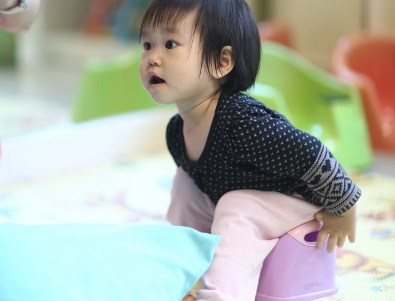 | Make a baby obstacle course!
Using pillows, cushions, towels and blankets, create simple but safe obstacle courses for baby to crawl and explore. Get down on your fours and join your baby in the fun. Always
supervise when baby is engaged with the obstacle course to ensure safety. |
| | |
| Fill 'em up and shake 'em out!
Encourage your toddler to fill an empty platic bottle with clothes pegs, then tip the bottle upside down and shake until the clothes pegs all come out! This activity can help
your toddler work on his fine-motor skills. |
| | |
| Provide your child with good nutrition and reduce processed food and sugar.
For babies and toddlers, give them plenty of opportunities to crawl and move around. Explore movements like jumping and walking on
tiptoe. Move to the music and make it fun!
~ Ms N. Pushpavalli, Principal of Ramakrishna Mission Sarada Kindergarten and ECDA Fellow |
| | |
| Be patient and encouraging.
Patience and encouragement may be the two most important factors which you can give generously when supporting your child's fine motor skills development. When your child feels
emotionally supported and recognises that she is competent and capable, regardless the challenges on hand, she can conquer anything she sets her mind to.
~ Ms Rebecca Jaclyn Smith, Senior Programme Specialist, Learning Vision |
| | |
| Promote your little one's sensitivity to touch.
Using her fingers by providing rich sensory tactile experiences. Provide experiences like sand play, squishing different textured sponges, exploring different
fabric textures, and even exploring a variety of materials such as dried leaves, finger paints, shaving cream or whipping cream.
~ Ms Rebecca Jaclyn Smith, Senior Programme Specialist, Learning Vision |
| | |
| Provide time for mastery!
The mastery of fine motor skills takes time, practice, patience, and an abundant dosage of encouragement. Try to understand the demands various activities have on your child's fine
motor skill abilities so that you are better able to put yourself in her shoes to render the support she needs.
~ Ms Rebecca Jaclyn Smith, Senior Programme Specialist, Learning Vision |
| | |
| Develop hand-eye coordination
by providing your infant with stimulating toys that will encourage her to practice reaching out for things and grasping them. For example, rattles, coloured scarves and even brightly
coloured balls. For toddlers, encourage them to feed themselves using spoons and cups!
~ Mrs Elsie Tan-Chua, Principal of Living Sanctuary Kindergarten |
| | |
| Hoops-a-daisy.
Place large hoops next to each other for your child to jump in and out of. Play some music and make this game even more exciting by playing musical hoops. Freeze in any position when the music
stops. Try different types of movement like tip-toeing, hopping and even skipping. |
| | |
| Finger painting anyone?
With non-toxic finger paints and large sheets of paper, your child can explore painting with her fingers and have loads of endless fun! |
| | |
| Water play is fun!
Fill a basin with water and provide objects such as funnels, containers, sponges, scoops and sieves. With adult supervision, your child will have endless opportunities of fun to practice
hand and finger movements. |
| | |
| Let's play ball!
Balls are versatile. Provide balls of various sizes for your child to kick, throw, catch and roll. Place a washing basket or a wide box on the floor. Have your child stand near to throw
the ball in. Encourage your child to gradually increase her distance from the container as she gets more comfortable with the throws. Remember to make it fun! |
| | |
| Pat-a-Cake.
Play simple hand games like Pat-a-Cake. If you have a younger infant, gently move her arms or pat her hands or feet. Have fun doing these simple actions while singing to the tune of 'Twinkle,
twinkle, little star' or 'Mary had a little lamb'. |
| | |
| Roll the ball.
Roll a ball to your child and encourage her to roll it back. You can help her develop eye-hand coordination and strengthen her gross and fine motor skills. Singa song or chant
"Roll, roll, roll that ball" as you roll the ball to your child. Make it fun! |
| | |
| Provide regular outdoor opportunities.
Bring your child outdoors to the playground, parks or the beach. Allow your child to engage in unstructured free play in these places. These places provide ample space
for your child to practice larger movements like running and jumping. Your child can also practise ball handling and manipulative skills like throwing and catching balls, pushing a swing, pulling a wagon, lifting and carrying
objects. |
| | |
| Tissue boxes make tall towers.
Collect boxes of different sizes and plan many fun developmental opportunities using these boxes. You can ask your child to build towers in different ways with these boxes. Challenge
her to build towers taller than herself. Stacking and balancing these boxes develop your child’s coordination skills and dexterity. Praise her for her efforts even if the towers come tumbling down in the end. |
| | |
| Read and tear.
Provide your child with old magazines to look at and tear. You may show her how to use the pincer grasp to hold the paper with both hands and then move her hands away from each other (one toward
her body and the other away) to tear it. The torn pieces can be used to form a collage or a piece of artwork. This allows your child to practise using her fingers in a coordinated manner and develops her fine motor skills. |
| | |
| Turn pages.
Let your child explore sturdy books that are made of hard cardboard, plastic or fabric. Have her to help in opening and turning the pages of these books during story time or on her own. This builds
her small muscles and it is a great way to introduce early literacy and book skills too. |
| | |
| Let’s scribble.
Provide your child with different writing tools such as large crayons, thick pencils and thick paintbrushes to make marks and scribbles. Mark making is one of the first precursors to
literacy acquisition and a great way for your child to develop those little fingers and hands to refine his fine motor skills. |
| | |
| Look Mum! I can put on my sandals.
Give your older toddler opportunities to pull up her shorts, slip her feet into sandals and attempt to fasten the strap by herself. Have patience and help only if your
child is struggling. This not only empowers your child, letting her know that she can dress herself, it also allows her to exercise her fine motor skills and hand-eye coordination. |
| | |
| Do action rhymes or songs with big movements.
Provide opportunities for your child to sing and try out simple movements that go with the songs like clapping hands, touching toes swaying body, or
swinging hands and legs. These help your child learn more about her body, practice her movement skills, and increase her interaction with and understanding of the environment. Make it a point to encourage your child with plenty
of positive reinforcement for her efforts, no matter how proficient her skills. |
| | |
| Finger foods are yummy.
Offer your child finger foods such as small pieces of fruit, vegetables, crackers or cereal. She can reach out for these, pick them up and put them into her mouth.
|
| | |
| I want that toy.
Place an object or your child’s favourite toy just slightly out of her reach. Encourage her to reach for it, kick it with her feet while she is seated or crawl towards it if she is at
the crawling phase. |
| | |
| Place objects within grasp.
For your younger infant who has yet to crawl, place objects of different textures, shapes and colours within her reach. |
| | |
| Make time for tummy time.
Short periods of tummy time offer your baby opportunities to practice lifting her head and raising herself on her elbows. Her muscles get strengthened in the process. |
| | |
| Hold your child up.
In this position, your child can explore by moving her head, arms and legs. |
| | |
| Help me to help myself.
Encourage your child to drink from a cup by herself or hold her spoon to feed herself. |
| | |
| Practice makes perfect.
Place your child in different positions to develop skills such as rolling, creeping, crawling or kicking. Place a mat or mattress on the floor for your child to crawl around. |

